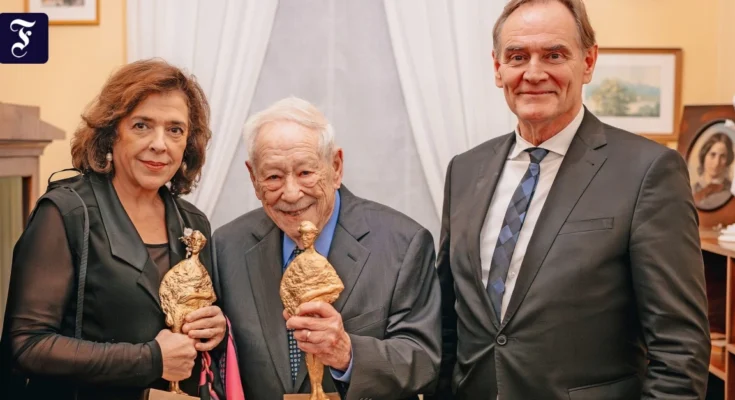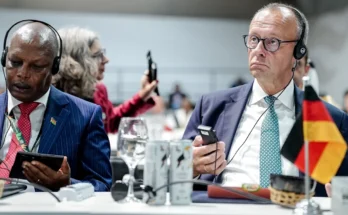Elena Bashkirova is a cheerful and fearless person. While the Gaza war was still in full swing, he went to Israel in early January this year to play Wolfgang Amadé Mozart’s KV 415 piano concerto. “People’s eyes widen when I say I’m going there,” he said, “but right now, right now, people need support. Through music! So it has to happen.”
Just like the Jerusalem Chamber Music Festival, which the pianist has directed for nearly thirty years. “This is one of the few secular cultural events in Jerusalem that is not guided by any religious interests,” he stressed. This form of culture has almost completely stopped in the city. And despite his understanding of the complexities of the political situation, he does not believe in a cultural boycott in any direction. “Our job as artists is to bring people together, not divide them.” This year’s edition in Jerusalem “started with rockets from Yemen” in September, he reported. “Wait ten minutes and everything is fine.” Like every edition, this one ends with a string octet by Felix Mendelssohn Bartholdy.
Today Bashkirova, who served as honorary president of the Felix Mendelssohn Bartholdy Foundation for five years, is also the recipient of the International Mendelssohn Prize in Leipzig. He recently received it at the Gewandhaus along with the nearly centenarian Michael Blumenthal, former US Treasury Secretary under Jimmy Carter and later founding director of the Berlin Jewish Museum. She has a lot in common with Bashkirova: “From the beginning, Michael wanted music to be part of the museum,” says the pianist, “so he founded Intonations, a sister of the Jerusalem Chamber Music Festival in Berlin.”
As emphasized by Patrick Schmeing, director of the Leipzig Mendelssohn House, Leipzig Mayor Burkhard Jung paid special attention to continuing the tradition of the Mendelssohn Prize. It started in 2007 with first prize winner Kurt Masur. Thanks to the former Gewandhauskapellmeister, the house where his predecessor Felix Mendelssohn Bartholdy lived and died at Goldschmidtstrasse 12 was saved and is now a museum. Meanwhile Helmut Schmidt and Peter Schreier, Marcel Reich-Ranicki and Riccardo Chailly received prizes; In 2016 – after the award to Tomoko Masur – the tradition was broken. Their resumption now complements the revitalization of the Mendelssohn Festival in Leipzig, where the city, the Gewandhaus and the Mendelssohn House work together happily – not only to commemorate Mendelssohn, but also to effectively develop Leipzig, the city of Bach, into a city of music.
Kremer came to Mendelssohn late
Until a few years ago, Mendelssohn was not his hero, violinist Gidon Kremer admitted during a salon conversation with Bashkirova at the Mendelssohn House. It was only through the recording of an early double concerto for violin and piano with pianist Martha Argerich that he got an idea of the extraordinary talent of this child prodigy and has not stopped wondering since. “I am like the Russian actor Innokenti Smoktunovsky, who was the wonderful Prince Myshkin in Dostoyevsky’s ‘Idiot’ on stage and who played Hamlet in Grigory Kosintsev’s film adaptation: he saw his job as an artist as being in awe of something and sharing this wonder with others.”
In Kremer’s concert with Kremerata Baltica and pianist Lucas Debargue, where the violinist reminds us with his blooming yet tender notes that all beauty is ultimately resistance to its dangers, the two giant prodigies of Mozart and Mendelssohn also meet head-on. Mozart with his passionate and pompous Piano Concerto in E flat major KV 449, Mendelssohn with the fourteen-year-old’s String Symphony in B minor, which, with its passionate earnestness, attests to a conceit that had lost all recklessness at an early age.
First Piano Concerto in G minor, Op. 25, written eight years later, also begins with concern: However, Andris Nelsons and the Gewandhaus Orchestra initially unleashed a destructive force. The impulse with which the piano solo reacts to this is ambiguous: flight and fight in equal measure. Solo singer Seong-Jin Cho somewhat misunderstood the seriousness of the situation by interpreting this threatening situation as an invitation to spread a lot of pearlescent glitter. He felt more at home in the lyric retreat, in the sensitively designed harmonic changes of the slow movement, and in the charming seduction of the final cause. Yet the progression from almost tragic self-assertion against a hostile environment to escape into contemplation to an active life regaining serene self-determination is told more by the orchestra than by the soloist.
The concerts of the Gewandhaus Youth Choir with Frank-Steffen Elster and the Gewandhaus Choir with Gregor Meyer were programmatically very impressive. In particular, “Annual Pictures” with Mendelssohn’s songs (also without words), whose piano parts were meticulously arranged by Andreas N. Tarkmann for flute, oboe, clarinet, trumpet, bassoon and harp, tell about the ability to read entire cycles of years metaphorically and about their young author’s graceful awareness of death.

The special exhibition “Unknown Beauty” about Mendelssohn’s wife, Cécile Jeanrenaud, is currently on view at the Mendelssohn House, where people are delighted with new acquisitions of Mendelssohn’s watercolors from the Amalfi Coast and watercolors by Ferdinand Schiertz from Mendelssohn’s final studies. The honeymoon couple’s diary, with text by him, compositions by him and fine drawings of the two of them, also tells of a responsible sense of gratitude that celebrates the life and beauty in their reserves. Mendelssohn died at 38, his wife at 36.



